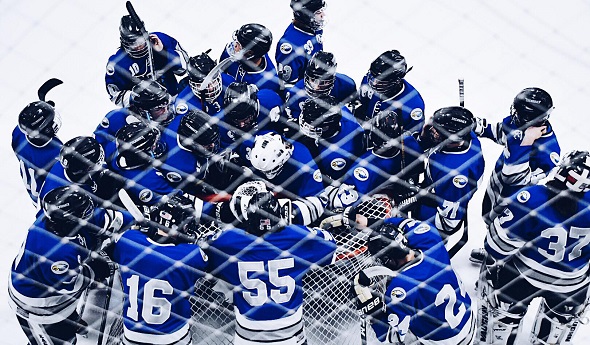
Numbers Add Up Nicely for Eisenhower
By
Tom Markowski
Special for Second Half
February 15, 2018
SHELBY TOWNSHIP – The game within the game continues to play out in boys ice hockey as coaches and communities strive to maintain competitive programs in an increasingly competitive world of high school athletics.
 Utica Eisenhower is ranked No. 6 in Division 1 this season and seeking its first MHSAA championship game appearance – which would be another fine accomplishment for a program that continues to measure up with the state's best.
Utica Eisenhower is ranked No. 6 in Division 1 this season and seeking its first MHSAA championship game appearance – which would be another fine accomplishment for a program that continues to measure up with the state's best.
Bob Hall is in his 11th season as Eisenhower’s head coach, and his program has maintained a high level of competitiveness and stability throughout his time. The Eagles reached Division 1 Quarterfinals in 2013 and 2016, and last season Eisenhower lost to eventual Division 1 runner-up Detroit Catholic Central, 5-2, in a Regional Final. In 2006, Eisenhower reached the MHSAA Semifinals.
Hall, 48, spent a number of years coaching Bantam-A and Junior-A travel teams before he took over at Eisenhower. He’s seen both sides of the coin as it relates to ice hockey in Michigan. Unlike a sport such as football, high school hockey coaches must compete with travel teams for talent. Some programs succeed; some don’t.
Eisenhower is one of stronger programs in the Metro Detroit area. Despite losing a dozen seniors to graduation last spring, Hall has 25 players on varsity this season, including 12 more seniors.
“High school hockey is the best-kept secret out there,” Hall said. “There’s nothing better than to have 1,000 people yelling for you in a rink and another 500 or so rooting against you.
 “Our program, it’s not that we’re developing so much. We see ourselves as the top program in Macomb County. There’s other good programs, too, like (Warren) DeLaSalle and (Macomb) Dakota. We’ve done three showcases this season. Our kids are being recruited. Unless you’re playing in the top three of four elite travel teams, high school hockey is just as competitive.”
“Our program, it’s not that we’re developing so much. We see ourselves as the top program in Macomb County. There’s other good programs, too, like (Warren) DeLaSalle and (Macomb) Dakota. We’ve done three showcases this season. Our kids are being recruited. Unless you’re playing in the top three of four elite travel teams, high school hockey is just as competitive.”
Some Metro Detroit high school programs have not been as fortunate. Fraser and Warren Mott high schools eliminated ice hockey after last season. Fraser won the Class A title in 1983, but times change.
Harrison Township L’Anse Creuse and Macomb L’Anse Creuse North used to sponsor their own programs. Now they compete as a unified team. The same can be said of St. Clair Shores Lake Shore and St. Clair Shores Lakeview. Large Class A schools like Sterling Heights Stevenson and Utica Ford no longer sponsor the sport.
The county has been impacted by these changes, and Hall is a bit taken aback by it.
Eisenhower is one of four members of the Macomb Area Conference Red, with Dakota, Romeo and St. Clair Shores Unified. The Eagles (15-3-2 overall, 5-0 MAC Red) will host Dakota (13-8, 4-1) on Saturday in what amounts to a game for the division title.
“Back In the day we had six or seven in the Red,” Hall said. “The more schools we get involved, the better. We want good hockey. There are good hockey players in this area.”
And Eisenhower is fortunate to have a number of fine players. Among the top seniors are centers Luke Geiger, Salvo Cipriano and Michael Acorn, and winger Matt Haist. All played on the team last season and have embraced their roles as leaders and role models for the younger players.
In goal Eisenhower has two sophomores, Salvatore Carabelli and Alex Guzdziol. Carabelli has logged the majority of playing time and sports a 13-3-2 record.
This is Haist’s second season with Eisenhower. Previously, he played for the Oakland Junior Grizzlies. He said that the time was right for him to make the switch after his sophomore year.
 Statistically, Haist is the team leader in points (53) and goals (37). Next is Jacob Latorella and Geiger each with 24 points.
Statistically, Haist is the team leader in points (53) and goals (37). Next is Jacob Latorella and Geiger each with 24 points.
“Coach Hall is a great coach,” Haist said. “(Playing at Eisenhower) has lived up to all my expectations. Generally, players don’t think high school hockey is that competitive. I don’t agree. There are a lot of good players. High school hockey has more of a demanding schedule. Yeah, we do play less games, but we practice so much more. In travel you might practice two or three times a week. Here we practice five days a week. The more time on the ice makes you better. It also makes you better conditioned.”
Haist said this team is good enough to make a long run in the tournament. He even said a Division 1 championship is not out of the question.
Hall won’t go that far. It’s not that he doesn’t think his team can win it all. It’s just that he won’t allow himself to look past the Regionals.
Eisenhower begins Pre-Regional play against Rochester Adams on Feb. 26 at Detroit Skating Club.
“We have talent,” he said. “Are we the most talented? No. This team gets along well. They bring their lunch box every day. They want to get better. They want to learn. And when they apply what we’re teaching, they’re a pretty good team.”
 Tom Markowski is a columnist and directs website coverage for the State Champs! Sports Network. He previously covered primarily high school sports for the The Detroit News from 1984-2014, focusing on the Detroit area and contributing to statewide coverage of football and basketball. Contact him at [email protected] with story ideas for Oakland, Macomb and Wayne counties.
Tom Markowski is a columnist and directs website coverage for the State Champs! Sports Network. He previously covered primarily high school sports for the The Detroit News from 1984-2014, focusing on the Detroit area and contributing to statewide coverage of football and basketball. Contact him at [email protected] with story ideas for Oakland, Macomb and Wayne counties.
PHOTOS: (Top) Utica Eisenhower players gather during a break in their 5-1 win over Traverse City West on Jan. 12. (Middle) Goaltender Salvatore Carabelli makes a save against Romeo. (Below) Senior Matt Haist starts a rush at Romeo’s net. (Photos by Lena Carabelli.)
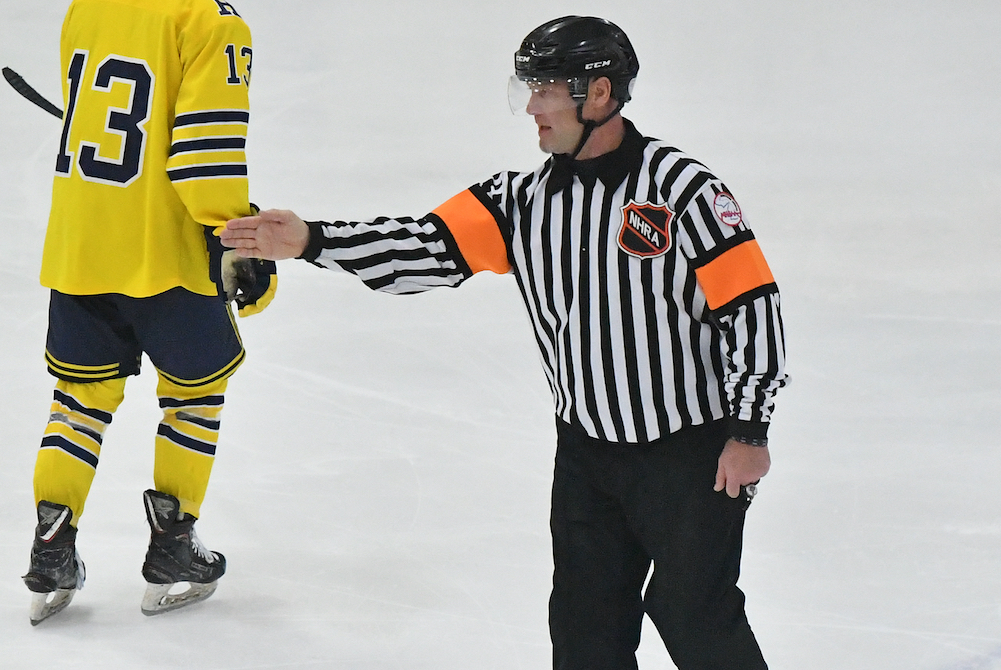
Retired NHL-er Back on Ice to Answer Call - By Making Them
By
Rob Kaminski
MHSAA benchmarks editor
March 16, 2023
The most accomplished skater on the ice during Friday’s triple-overtime MHSAA Division 1 Semifinal hockey thriller between Hartland and Brighton was not wearing the school colors of either team.
In front of a packed house at Plymouth’s USA Hockey Arena, referee Bryan Smolinski was in stripes, just like the rest of his officiating crew.
In his former life, he pulled on plenty of sweaters before lacing up the skates. That happens when one logs more than 1,000 games, tallies nearly 300 goals (274) and close to 400 assists (377) with eight teams spanning a 15-year playing career in the National Hockey League.
So, how did the 52-year-old former star player find himself on the ice last weekend as one of the referees for the pinnacle weekend of this high school season? Good question, even for the man known as “Smoke” during his playing days.
“I was working in youth development programs a few years back and reached out to some Michigan guys I had connections with about other ways to help the game,” Smolinski said. “I called Kevin May just to chat and asked, ‘Hey, how’s your reffing going?’ He said, ‘You know, we’re down a little bit,’ then said, ‘Why don’t you do it?’ I said, ‘Not a chance,’” Smolinski laughed.
Never Say Never
May persisted, imploring his friend to skate with him during a Fall league at Cranbrook in Bloomfield Hills. After eight weeks, once a week, Smolinski had a revelation.
“I’m like, ‘I’m kind of diggin’ this,’” Smolinski said “So, I did all the testing, and the educational part of it, and I really enjoyed it. I got with Danny (DiCristofaro) and his group, and he put me in as much as he could, and I really started to get my feet wet.”
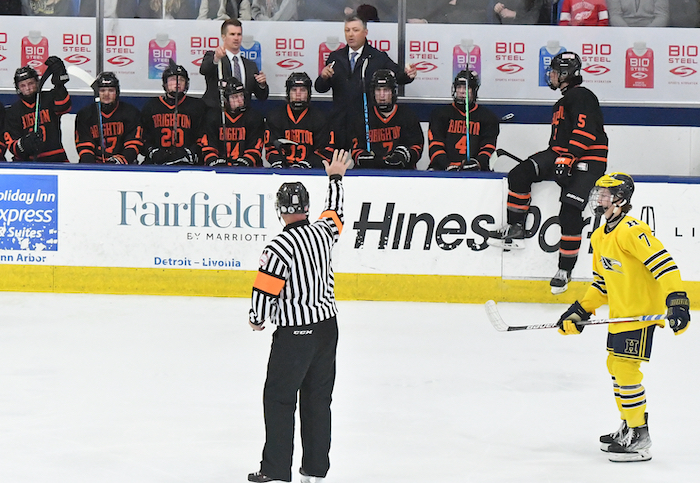 DiCristofaro is the assigner and referee-in-chief for the MHSAA’s Northeast Hockey Referees Association, and he has seen Smolinski’s growth first-hand.
DiCristofaro is the assigner and referee-in-chief for the MHSAA’s Northeast Hockey Referees Association, and he has seen Smolinski’s growth first-hand.
“Obviously he’s got great instincts and a feel for the game, along with a wealth of experience, all of which has allowed him to climb the ladder quickly,” said DiCristofaro. “It’s been a joy to watch his growth as an official.”
Fast forward to last Friday, and there were Smolinski and May sharing duties as referees during the MHSAA Semifinal with linesmen Michael Andrews and Thomas Robbins.
In between, there has been a learning curve that still continues, but the jump to officiating was not quite as daunting as his introduction to the NHL.
“I was scared to death. My first game was against Mario Lemieux. I’m in the old Boston Garden and now I’m playing against these guys and it’s their job, and they’re out there trying to make a living,” Smolinski recalled.
The emotions were not running nearly as frenzied for his first game as an MHSAA official, obviously, yet respect came in a different form.
“I couldn’t pick the puck up, I was breathing heavily; it was Kevin and me doing a two-man game in Brighton,” Smolinski recalled. “There were a few high-end kids playing, and I’m thinking, ‘I’m dying here.’ You know, there’s no training for that first time.”
What that experience did, however, was revitalize Smolinski in a new way. His playing career is well documented, not only in the NHL, but around Michigan. He enjoyed an honor-laden career at Michigan State University from 1989-93 before joining the Boston Bruins (who had drafted him three years earlier) at the end of the ’93 NHL campaign. Even after his final season, with Montreal in 2007-08, he stayed in the game via men’s leagues, or coaching his son, Max.
Smolinski and his wife, Julie, have three daughters: Ashtyn (22), Jojo (16) and Rylen (12), along with Max, whom dad coached for seven years including during a national championship run with a Little Caesars U15 team in 2019. Max, 19, is now playing collegiately at Rensselaer Polytechnic Institute.
So, for Smolinski, officiating offers a new chapter.
“Reffing brought back ... I wouldn’t say love of the game, because that’s always been there; it’s a different side of enjoying the game now. I have no horse in the race, my son’s off to college, my daughters are doing their thing; I wanted to find something new in the game,” Smolinski said. “I’ve coached, and I don’t want to do that. I found this, and I’ve stuck with it.”
Old College Ties
One of the great benefits of athletics at any level are the friendships made. For two kids who met in their first years on the MSU campus and forged a bond that lasts to this day, it’s amazing how their careers reached the pinnacle and have now come full circle.
Wes McCauley, an MSU teammate, is one of Smolinski’s best friends. After numerous years in the minor leagues, McCauley, like his friend, made it to the NHL. But McCauley made it as an official, working his first NHL game in 2003, when Smolinski was nearing the end of his playing career.
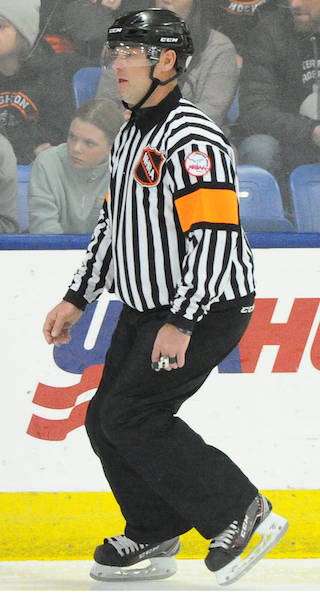 Their games lined up on just a few occasions in the NHL, and the two lobbied hard to have McCauley work Smolinski’s 1,000th career game in his final season with the Canadiens in 2007-08. The request, sadly, was denied by the league.
Their games lined up on just a few occasions in the NHL, and the two lobbied hard to have McCauley work Smolinski’s 1,000th career game in his final season with the Canadiens in 2007-08. The request, sadly, was denied by the league.
On the rare occasions when the friends did share the same ice, less than a handful by Smolinski’s count, it was McCauley who was forced to rebuff any attempts at fraternization. It’s just part of an official’s edict.
“For both of us, it was amazing; it was just great,” Smolinski said. “I’d say, ‘Hey man what’s up?’ and he says, ‘Can’t talk.’ I’m like, ‘What do you mean, we talk all the time.’ Again, he’s like, ‘Can’t talk, get away from me.’ You know, it was just business.”
McCauley then reached the 1,000-game plateau himself in 2018 and is still going strong as a regular selection for playoff duties with nine Stanley Cup Finals assignments, including last year.
So, it should have been natural for Smolinski to go to his old friend immediately for officiating pointers once he joined the ranks, right? Well, maybe not immediately.
“I talk to Wes all the time, but I actually hid it from him right out of the gate because I didn’t want to take his razzing. Eventually it got out, and he was loving it. He started sending me whistles and visors and pants,” Smolinski said, grinning. “And none of it fit, you know, because I’m older and fatter, and he’s so damn skinny. So, I still had to go out and get all new gear.”
Both Sides Now
Having been to the top of his profession, now moving to the other side of that same mountain that his friend McCauley scaled, the respect has grown for those blowing the whistle.
“The preparation for officiating is much more mental,” Smolinski said. “Way more rules oriented. You’re always trying to get away with things that you can as a player; now you have to police that.”
Smolinski has a distinct advantage.
“I know everything they’re trying to do because I’ve done it. I know where you’re going with the puck, I know what kind of breakout you’re trying to do,” Smolinski said. “I have all the instincts, now I just try to stay out of the way and not ruin their game. The most fun is watching the game develop and the ups and downs. For me to be out there and enjoy it with them, that’s the fun part.”
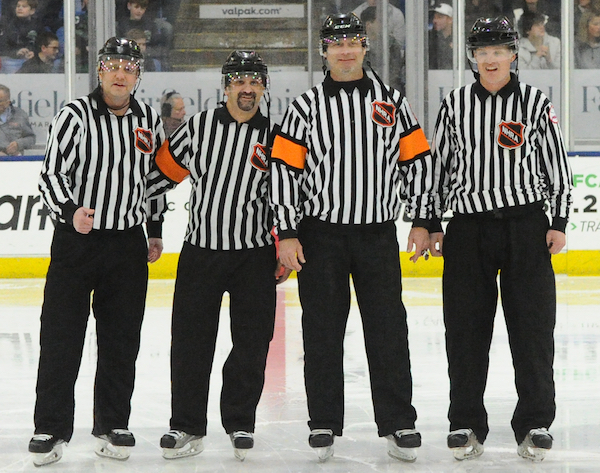 Those who have played hockey at any level have a built-in advantage should they consider the officiating avocation: the ability to skate. Unlike officiating in any other sport, skating is a prerequisite. This makes the pool limited, and almost solely composed of former players. Smolinski offers this advice.
Those who have played hockey at any level have a built-in advantage should they consider the officiating avocation: the ability to skate. Unlike officiating in any other sport, skating is a prerequisite. This makes the pool limited, and almost solely composed of former players. Smolinski offers this advice.
“I prefer sticking with high school because I think there’s more decorum, more administrative structure. Kids are playing for their schools, there’s loyalty there,” said Smolinski. “And there is more accountability. People need report to athletic directors and supervisors. Other levels can be more loosely governed, or a bit more maverick in nature. Moms and dads get involved more, coaches maybe know a little less,” said Smolinski.
He has, in fact, worked a handful of non-school games, and there’s a stark difference.
“I wanted to see what was going on, and I see it first-hand,” Smolinski said. “There are some crazy people and parents out there, and these guys are getting absolutely tortured. I’ve been tortured. There has to be a level of respect for what officials do. I think schools can rein that in a little more. All the guys I’ve met give up a lot of time and work hard because they love to do it and love the game.”
All sports need an assist from school administration and from those who once played the games to keep the officials recruitment moving in the right direction. People like Smolinski can help.
“He clearly doesn’t need to do this, and that’s what makes it so fantastic,” DiCristofaro said. “We need more people who have played – at any level – to do what he’s done and stay in the game as officials.”
Smolinski continues to promote the game in other ways as well. Currently, he is involved in the NHL’s Learn To Play initiative, which aims to inspire youth and welcome more families into the hockey community.
“We work hand-in-hand with the NHL Players Association for player development and industry growth,” Smolinski said. “Ages 5 to 9 are introduced to hockey, get head-to-toe gear and instruction, and meet some former players.”
The idea is to have fun first, which can translate into years and maybe even a lifetime in the sport. It’s a lifetime that has given Smolinski so much and continues to do so as he watches it unfold for others from his new vantage point.
PHOTOS (Top) MHSAA official Bryan Smolinski signals during Friday's Division 1 Semifinal between Brighton and Hartland. (2) Smolinski, a retired NHL standout, communicates with the Bulldogs' bench. (3) Smolinski keeps watch during game play. (4) Smolinski, third from left, with his crew: Michael Andrews, Kevin May and Thomas Robbins.

